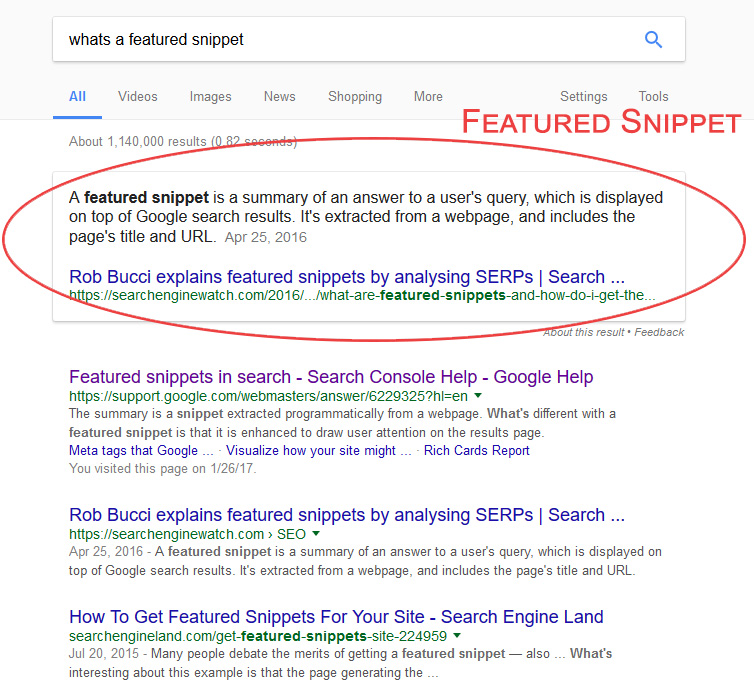Search engine optimization will always be an important topic for web design (despite what some may say), and 2017 is no different. Here are some of the interesting SEO trends for the new year.
1. More Featured Snippets
What’s a featured snippet? A featured snippet is an answer to a question you search for on Google that is displayed directly on the Google results page. It is pulled from a webpage, and includes the title and URL of that webpage.
The best way to explain it is to show you. If you were to do a Google search for “What’s a featured snippet?”, the below screenshot is similar to what you will see.
Experts see a rise in the use of featured snippets, especially as websites start to compete for them. It’s very beneficial to be ranked #0 as they call it on Google, where a user doesn’t even have to click on your website to see your content. It’s like you get a free pay-per-click ad at the top of Google.
How to utilize featured snippets for your website
The best way to get your website on Google’s featured snippets is to have direct answers to questions in your content. Use concise, clear language that answers the question quickly and succinctly. Also make sure to use proper markup, with p tags, li tags, and tables (when applicable).
2. Focus on Quality Content vs. Keyword stuffing
Keyword stuffing is putting large amounts of unnecessary keywords in a web page in order to manipulate the search engines to rank higher. In 2017, this will be tolerated even less by Google. Well written, clear, unique, good content will be what really impacts SEO. Google’s algorithms are getting much better at finding out what content is legit and what is not.
Repeating keywords over and over won’t help. Looking at keyword density won’t help. Google can tell what you’re writing about from the surrounding context of your page.
We still recommend doing keyword research to include and even feature on your pages. However the practice of repeating that keyword over and over, or even putting that same keyword everywhere on your website, will not be an effective search engine optimization strategy. That’s why we think that in 2017, the focus will be on writing quality, unique content.
3. Mobile First
We’ve been saying for years that more and more people are using their phones on the internet. And more recently, Google has told us that if a website is not mobile friendly, it will hurt rankings. Mobile is mandatory.
Now we know that mobile is not only necessary, it’s the priority over desktop. Google’s “mobile-first index” is a really big deal for SEO experts or anyone with a website. Why? Because instead of indexing the internet from a desktop computer’s point of view and basing rankings off the content, Google will now place much more emphasis on the mobile version of a website’s content.
Practical application – let’s say you have a desktop version of your website, and a mobile-only version of your website, with different content on each. The mobile-only version does not include every page that the desktop version has. In other words, it’s a smaller website, maybe with only a few pages, contact info, pictures, etc.
Your mobile website is likely to drop in the SERPs. Why? Because it no longer has as much content as it used to, before Google looked at mobile-first.
Make sure that your mobile website has just as much quality content as your regular website – no more “separate” websites. It should have the same content, and just be optimized for smart phones.
Here are Google’s thoughts on the matter of mobile-first indexing.
4. User Experience will matter more
Years ago there was a clash between UX and SEO. Search engines wanted lengthy content, LOTS of keywords, etc. Users wanted short, concise, easy to read content.
In 2017 and beyond, Google will focus even more on how the user interacts with a web page. If your page doesn’t satisfy the user in their quest for answers, Google has provided them with the wrong page. They will want to fix that.
How Google goes about measuring user experience isn’t clear right now, and it may never be perfectly clear. But there are a couple ways in which they may be able to tell.
Potential Ways to Measure UX (user experience)
- Social sharing – sharing a page with social platforms is a clear signal to Google that the user was happy with what they found.
- Online forms – filling out an online form is another good sign that the user was positively interacting with a web page.
- Time spent on the page – If a user doesn’t dwell on the page very long and immediately hits the “Back” button followed by a click on a different page, they obviously didn’t find what they were looking for.
- Clicks – if a web page is #1 on Google but more people click on the lower ranked links, the #1 page will likely drop. A poorly written title tag, URL, or meta description may contribute to this.
Application – make sure that your content is engaging and written with users in mind, not search engines. Writing specifically for the search engines will not be nearly as effective as it once was.
5. Website Speed
Part of a good user experience is how fast a website loads. It’s not hard to make the leap that if Google is going to put such a heavy focus on UX, that page load speed will be a factor.
Application – you don’t want to have a slow website anyway, but now there is even greater reason to have a fast website. Drop anything “extra” that you don’t need on your website (especially your mobile website) that is slowing down the page.
Final Thoughts
The emphasis on user experience is rapidly growing. Spend less time and money on trying to trick the search engines into believing your website is the best, and instead work on making your website the best.


